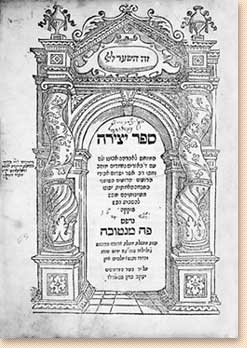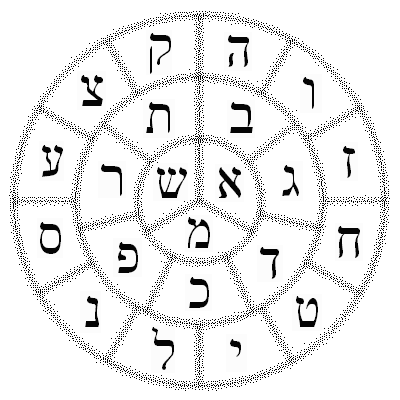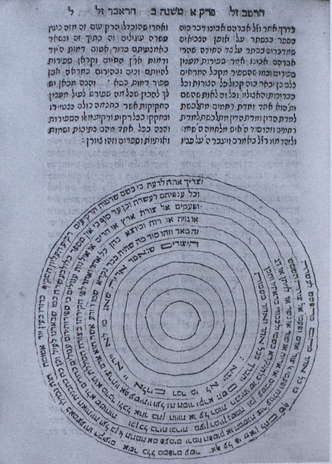Sefer Yetzirah
The Sefer Yetzirah (Hebrew: ספר יצירה, "Book of shaping " or " Book of Creation " ) is an ancient, in the Jewish context has become known cosmological and scientific treatise that the essential elements of creation in their creation ( cosmogony ) and their representing structure. These elements are the 10 Urziffern ( Sephiroth ) and the 22 letters of the Hebrew alphabet.
The Sefer Yetzirah has been commented rich in Jewish tradition from the 10th century. According to the rational presentation of the book initially were philosophical and scientific approaches in the foreground. Later (from the 12th century) it was mystical and speculative interpreted and so justifies the importance of the book of the Kabbalah. It is often referred to as the oldest independently surviving work of Kabbalah, although it is actually more to see of his character here as a purely cosmological and scientific treatise and no Jewish religious- theological statements to be made. His idea of creation is radically different from that of the book of Genesis, and its interpretation in the Talmud and Midrash, it mentioned in any line of the people of Israel, nor any of its religious beliefs, customs or authorities. His influence on the content of the Kabbalah, however, is considerable, so that it is necessarily " vorkabbalistisch " classified as.
Origin and history
According to Jewish oral tradition of the biblical Abraham is regarded as the author of the work, within the meaning of " low- writer ", which it had received in his " initiation" by Melchizedek. The text itself does not mention any writer, however, mentions Abraham as the first who has gone the way of wisdom described, followed by supporting the adoption of its authorship.
The scientific study of the genesis of the book has led to very different results. Some researchers the work is placed in the Graeco -Roman antiquity. Heinrich Graetz saw it first a response to the Gnosis and dated it in the 2nd or 3rd century, as Gershom Scholem. However, recent research see a dependence on Islamic traditions and set the origin accordingly only after the 7th century. But these theories has been contradicted Recalling parallels the philosophy of Philo of Alexandria, resulting in an early dating even follows the 1st century. Final answers to the question of the historical classification is not possible, however, a development that is certain before the 10th century.
The textual tradition of the work is unclear. There are hand-written short and long versions, but their relationship to each other is disputed. For the long version, especially the handwriting Ms. Vatican 299 from the 10th century, to the summary part of the manuscript Ms. London 6577 from the 14th century. In addition, occurs early text version that has become known as Sa'adjanische review. It goes back to the Jewish scholar Saadia Gaon († 942).
The first printing - in a Latin translation - was made in 1552 in Paris. The first printed Hebrew edition took place in 1562 in Mantua. There are today various expenses, partially cover the implicit commenting texts.
Content
The Sefer Yetzirah itself in the most comprehensive versions of barely more than 2000 words. It provides 32 tracks of wisdom is that composed of 10 digits, the Sephiroth, and the 22 Hebrew letters.
Sephiroth
The term Sephiroth (Hebrew ספרות, singular: Sephirah - ספרה ) is a re-creation of the book Yetzirah. He goes back to the Hebrew verb stem sfr ( ספר, see Sefer Yetzirah § 1), the "count", " write ", " tell " and also as a noun " book" ( sefer ) can mean. Most Sephira is translated as " number". It is etymologically related but also σφαιρα with the Greek word, and is therefore rendered as " sphere " or " element ".
The ten Sephiroth are symbols of the dialogic structure of the world:
- Before - After
- Good - evil
- Male - Female
- High - Low;
Stand by the four cardinal directions
- East - West - North - South.
The Sefer Yetzirah knows no names of the Sephiroth, as they have become a structure-forming later in the Sephiroth or Tree of Life. The names are assigned to the ten digits only from the 13th century in the Zohar and subsequent kabbalistic works.
Letters
By far the largest part of the book is devoted to the meanings and relationships of the Hebrew letters. The 22 letters are divided into groups and assigned to the basic dimensions of time, the world and man:
Aleph, Mem, Shin
Beth, Gimel, Daleth, Kaph, Peh, Resh, Thaw
Heh, Vav, Zayin, Chet, Tet, iodine, Lamed, Well, Samech, Ayin, Zade, Qoph
Importance
The Sefer Yetzirah has taken with the teaching of the 10 Sephiroth significant impact on the Kabbalistic tradition in Judaism. The Sephiroth constitute the elements of the tree of life, and thus provide the most effective symbol of Kabbalah at all and will produce evidence the later versions to their shape and their relationships to each other in the Zohar and the subsequent teaching and living traditions.
The speculation about the Hebrew letters and their tripartite structure have also achieved greatest effect in Judaism and beyond in other mystical traditions. The most common example of this is the modern Tarot. The assignment of the 22 cards of the " Major Arcana " was modeled on the structure of the letters in the book Yetzirah of known Tarot arms up into the details.
The 1995 published novel " The alphabet of Judah Liva " by Benjamin Stein relates structurally to the letters Sefer Yetzirah Categories and plays their meanings and effects options through.
Comments
Annotated Texts
Hebrew and German:
- Lazarus Goldschmidt: Sefer Jesirah. The Book of Creation. Kauffmann, Frankfurt am Main 1894 reprint. Aurinia, Hamburg 2004, ISBN 3-937392-14-9 ).
- Giovanni Grippo: Sepher Jesirah. The Book of Creation G.G. Verlag, 2nd ed. 2008, ISBN 978-3-9810-6223-6
- Aryeh Kaplan Sefer Yetzirah - The Book of Creation in Theory and Practice. Ruther, Grevenbroich 2007, ISBN 978-3-929588-25-5 ( published posthumously, so comments are partially disordered note collection ).
- Guillaume Postel, Wolf P. Klein (ed.): Sefer Yetzirah. From man - Holzboog, Stuttgart 1994, ISBN 3-7728-1623-1.
German:
- Klaus Herrmann ( ed.), Sefer Yetzirah - Book of Creation. Publisher of the World's Religions, Frankfurt am Main, inter alia, 2008, ISBN 978-3-458-70007-4.
Hebrew and English:
- A. Peter Hayman, Sefer yeṣira. Edition, translation, and text -critical commentary. In: Texts and studies on ancient Judaism 104 Mohr Siebeck, Tübingen 2004, ISBN 3-16-148381-2.
Texts online
- Http://faculty.biu.ac.il/ ~ barilm / yezifra.html ( Hebrew with Hebrew commentary)
- Http://www.sacred-texts.com/jud/yetzirah.htm ( English translation by William Wynn Westcott )
- Http://www.psyche.com/psyche/txt/scholem_sy.html ( English translation by Gershom Scholem )
- Http://www.wbenjamin.org/saadia.html ( English translation including the commentary of Saadia )










